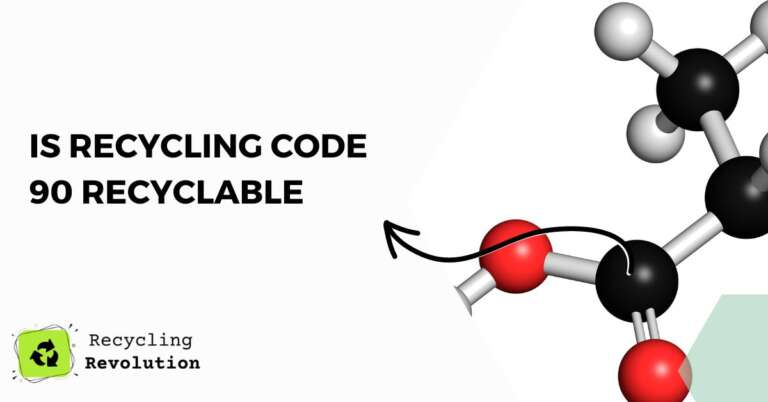In a world increasingly aware of the environmental impacts of waste, the recycling symbol – three arrows forming a Mobius strip – has become an iconic representation of our responsibility towards the planet.
Accompanied by a number, this symbol signifies the type of plastic the item is made from. Recycling code 90, however, is one that’s less known.
The materials denoted by this recycling code are typically bioplastics. Bioplastics are a type of plastic derived from renewable sources, such as vegetable fats and oils, corn starch, or microorganisms.
While these materials are often touted as a more environmentally friendly alternative to traditional petroleum-based plastics, their recyclability is a topic of debate.
TL;DR: Despite the ubiquity of plastics in today’s society, many of them are not recyclable. Recycling Code 90 is not typically recyclable in most curbside recycling programs. This is due to its unique characteristics and the specialized recycling process required to properly handle and reuse this material.
Navigating the Bioplastic Maze
The complexity surrounding the recyclability of bioplastics stems from their diversity. Various types of bioplastics exist, each with its unique properties and composting requirements.
Some bioplastics, like PLA (Polylactic Acid), are industrially compostable under the right conditions, but not recyclable in the traditional sense. Other bioplastics, like PHAs (Polyhydroxyalkanoates), are both compostable and marine degradable.
The primary challenge with recycling code 90 materials is that they require specific conditions and facilities to be properly processed. Unlike common plastics such as PET (Polyethylene Terephthalate – recycling code 1) and HDPE (High-Density Polyethylene – recycling code 2), which are widely accepted in municipal recycling programs, bioplastics are not universally recyclable.
The Recycling Process for Code 90
Recycling bioplastics, specifically, requires a specialized industrial composting facility that can maintain the high temperatures (around 60 degrees Celsius or 140 degrees Fahrenheit) needed to break down these materials.
Unfortunately, these facilities are not yet widespread, and the bioplastics may not decompose in regular compost piles or in landfills, where the conditions are not right.
I recommend always checking with your local waste management facility to understand what types of materials are accepted. Some facilities may accept bioplastics for composting, but many do not.
It is also important to remember that bioplastics should not be mixed with traditional plastics, as they can contaminate the recycling stream.
Understanding the Dilemma: Bioplastics and Recycling
A significant point of confusion surrounding recycling code 90 bioplastics lies in their misleading perception as “green” or “eco-friendly” alternatives. While it’s true that bioplastics are derived from renewable resources, they don’t inherently result in less waste or environmental impact.
In fact, some types of bioplastics release methane, a potent greenhouse gas, when decomposing in a landfill. This distinction is vital to comprehend as it influences how we manage bioplastics at their end-of-life stage.
Breaking Down Bioplastics
One of the biggest challenges facing the recyclability of bioplastics is their resistance to decomposition under typical conditions. Bioplastics require specific circumstances, usually achievable only in industrial composting facilities, to properly break down.
To effectively compost bioplastics, high heat, controlled humidity, and a specific microbial environment are needed – conditions not usually available in the average home compost pile or municipal composting facilities. Even when these conditions are met, some bioplastics, such as PLA, may take several months to completely decompose.
I recommend considering home compostability when choosing bioplastics. Some new bioplastics are designed to break down in home composting systems, which can be a more viable option for their disposal.
Impact of Mismanaged Bioplastics
When bioplastics are not properly sorted and end up in conventional recycling streams, they can cause significant problems. Bioplastics mixed with regular plastics can contaminate the whole batch, rendering it useless for recycling.
On the other hand, when bioplastics are dumped into landfills, they often don’t decompose any faster than traditional plastics due to the lack of oxygen. Some bioplastics, as mentioned earlier, may also release methane in these environments, contributing to global warming.
The Need for Better Infrastructure
A robust composting infrastructure capable of managing bioplastics on a large scale is currently lacking in many regions. Without this, bioplastics may not offer a significant environmental advantage over traditional plastics.
To make recycling code 90 truly recyclable, substantial investments in composting infrastructure are needed. The challenge lies not only in building these facilities but also in educating the public about the need to segregate bioplastics from traditional plastics and ensuring they reach the right facility.
The Future of Bioplastics
It’s evident that while bioplastics hold promise as an alternative to petroleum-based plastics, their management poses significant challenges. In the face of these challenges, scientists and researchers are continually working on innovative solutions.
One such promising development is the creation of entirely new types of bioplastics designed to decompose under normal environmental conditions or in home composting systems.
I recommend staying informed about the latest developments in this field. An understanding of new materials and technologies can help us make better decisions about the products we use and how we dispose of them.
Rethinking Our Approach: Reduce, Reuse, Reimagine
While we work towards more sustainable materials and better waste management infrastructures, it’s important to remember that recycling or composting should not be our first line of defense against plastic waste. Instead, reducing consumption and reusing items are the most effective ways to mitigate the environmental impacts of waste.
We can also reimagine the way we use materials. For instance, by designing products to be easily disassembled and recycled, or adopting models such as “product-as-a-service” where companies retain ownership of their products and are responsible for their end-of-life disposal.
In the end, tackling the issue of plastic waste requires a multi-faceted approach – one that combines innovative materials, effective waste management, and above all, a shift in our consumption habits.
Note: While the nuances of recycling code 90 and bioplastics might seem overwhelming, remember that every step, no matter how small, counts. Even simple actions like using a reusable shopping bag or refusing a plastic straw can have a significant impact when multiplied by millions of people.
Alternative Advice
There are several ways you can contribute to the solution of this complex issue:
- Reducing plastic consumption: This is perhaps the most impactful action one can take. Consider alternatives such as glass, metal, or even natural materials such as bamboo or wood for everyday items.
- Reusable items: Instead of single-use items, choose reusable items. From water bottles to shopping bags, making the switch to reusable can significantly reduce waste.
- Proper sorting of waste: Ensuring that you’re correctly sorting your waste can significantly impact the efficiency of recycling programs. It prevents contamination of recyclable materials and ensures that the correct items are reaching composting or recycling facilities.
Note: It’s essential to remember that recycling is just one aspect of the waste management hierarchy. The motto “Reduce, Reuse, Recycle” places recycling as the last option for a reason. The best way to minimize waste and its environmental impacts is to reduce consumption and reuse items as much as possible before resorting to recycling.
Conclusion
To answer the question, “Is recycling code 90 recyclable?” – The answer is no, not in the traditional sense and not commonly in most curbside recycling programs.
While bioplastics offer promising alternatives to traditional plastics, it’s important to understand their limitations and the complexities involved in their waste management.
We must focus on comprehensive solutions that prioritize reduction and reuse, alongside the development of more robust recycling and composting infrastructures.
FAQs
What is recycling code 90?
Recycling code 90 typically represents bioplastics – a type of plastic derived from renewable sources.
Is recycling code 90 recyclable?
Generally, recycling code 90 is not recyclable in most municipal recycling programs due to the need for specialized composting facilities.
What can I do to help manage bioplastic waste?
You can help by reducing plastic consumption, using reusable items, and properly sorting your waste. It’s also vital to educate yourself and others about the different types of plastics and their disposal requirements.
What are some alternatives to bioplastics?
Alternatives to bioplastics include materials such as glass, metal, bamboo, or wood. Additionally, choosing reusable items over single-use ones can significantly reduce the need for any type of plastic.

